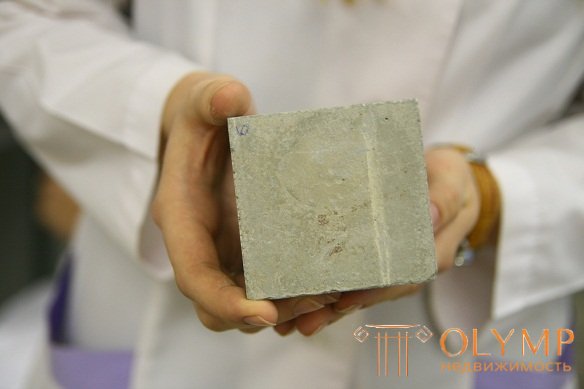
Concrete is an artificial stone-like material resulting from the hardening of a mixture consisting of binder, water and aggregates.

Concrete must have sufficient strength, good adhesion to the reinforcement and density, which protects the reinforcement from corrosion and durability of the structure.
Depending on the bulk density (density), concrete is distinguished on dense aggregates (heavy concrete) , cellular, on porous aggregates (light concrete). Heavy concretes with a density of D2200-D2500 kg / m3 have received the most extensive use in construction. The strength of heavy concrete reaches up to - 80 MPa and higher.
Concretes with a density of more than 2500 kg / m3 are extra heavy . They are used for protection from radiation and are prepared using special types of aggregates with a higher density.
Concrete on porous aggregates has a density of not more than D220 kg / m3. The strength of such concrete usually does not exceed 40-50 MPa. Porous aggregates are expanded clay, etc.
Due to the lower sound and thermal conductivity of concrete on porous aggregates, it is widely used in civil engineering. Low density makes it particularly appropriate to use in the construction of engineering structures.
Cellular concrete includes gas and foam concrete. The strength of this concrete is 15 MPa.
In designs with high t-swarm - open-hearth. workshops, chimneys, apply heat-resistant concretes.
Concrete strength
Concrete has different strengths under different force effects: compression, tension, bending, shearing. In this regard, several characteristics of concrete strength are distinguished.
For judgments about the strength of concrete, the indicators taken into account that are selected when designing structures are called the class and brand of concrete.
Depending on the purpose and working conditions of the reinforced concrete structures, concrete quality indicators are established, the main of which are:
a) Concrete strength class B ( beton ) fr. - Must be installed in the project in all cases;
b) Bt tensile strength class ; should be assigned in cases where this characteristic is of paramount importance.
c) Mark for frost resistance F; should be assigned to structures exposed in the wetted state to alternating freezing and thawing. The number after the letter F corresponds to
d) the number of sustained cycles of freezing and thawing in a water-spreading state.
e) Watertightness mark W; should be assigned to structures that require impermeability. (the number after the letter W corresponds to the highest water pressure in km / cm2 at which no water seeps through the concrete yet).
f) Mark on average density D; should be assigned to structures to which the requirements of a specific density. (the number after the letter D corresponds to the average density of concrete in kg / m3)
For reinforced concrete structures, the following classes and grades of concrete are provided:
a) Class of concrete for compressive strength:
Heavy concretes - В3,5; AT 5; B7.5; AT 10; B12.5; B15; IN 20; B25; B30; B35; B40; B45; B50;
B55; B60.
Light concretes with average density mark:
D800 - B2; B3.5; AT 5; B7,5
D1000 - B2; B3.5; AT 5; B7.5; AT 10
It is allowed to use intermediate classes of concrete for compressive strength B3;
AT 4; AT 6; B22.5; V27.5;
b) Cl. tensile strength Bt
Heavy, fine-grained and lightweight concrete - Bt 0.8; Bt1,2; Bt1,6; Bt2,4; Bt2,8; Bt3.2. For concretes of other types the class for tensile strength is not assigned.
c) Brand for frost resistance F:
heavy and fine granular concretes: F50; F75; F100; F150; F200; F300; F400; F500.
Lungs: F25; F35; F50; F75; F100; F150; F500.
Cellular: F25; F35; F50; F75; F100.
g) Brand waterproof W:
Heavy, fine-grained and lightweight concrete: W2; W4; W6; W8; W10; W12.
For concretes, other types of impermeability marks are not assigned;
Stamps on average density D:
Heavy concrete D2300; D2400; D2500;
Light concrete: D800; D900; D1000; D1700; D1800; D1900; D2000; D2100.
The age of concrete, corresponding to its class of compressive strength, is assigned during design, based on the possible real terms of loading the structure with design loads, the method of construction, and the conditions of concrete hardening. In the absence of these data, the class of concrete is established at the age of 28 days.
It is recommended to take a class of concrete for compressive strength:
for reinforced concrete elements made of heavy and light concrete, calculated on the impact of repetitive loading not lower than B15;
for reinforced concrete elements from heavy and light concrete not lower than B15;
for heavily loaded, compressed rods (for example: for columns that accept significant crane loads, and for columns of lower floors of multi-storey buildings), the prism strength is not lower than B25.
Prism concrete strength Rbn.
Concrete tensile strength Rbtn
Deformation of concrete under load.
1) Creep concrete.
Deformation of concrete under load due to its specific structure. The properties of concrete to increase the deformation under the action of a long applied load is called concrete creep. When calculating this phenomenon it is necessary to take into account certain factors.
Concrete shrinkage.
Shrinkage is the property of concrete to decrease in volume when cured in air. If uneven shrinkage may appear cracks. Shrinkage stresses are reduced with the appropriate selection of the composition of concrete, by moistening the surface, using a device for shrinking seams.
Что бы оставить комментарий войдите
Комментарии (0)